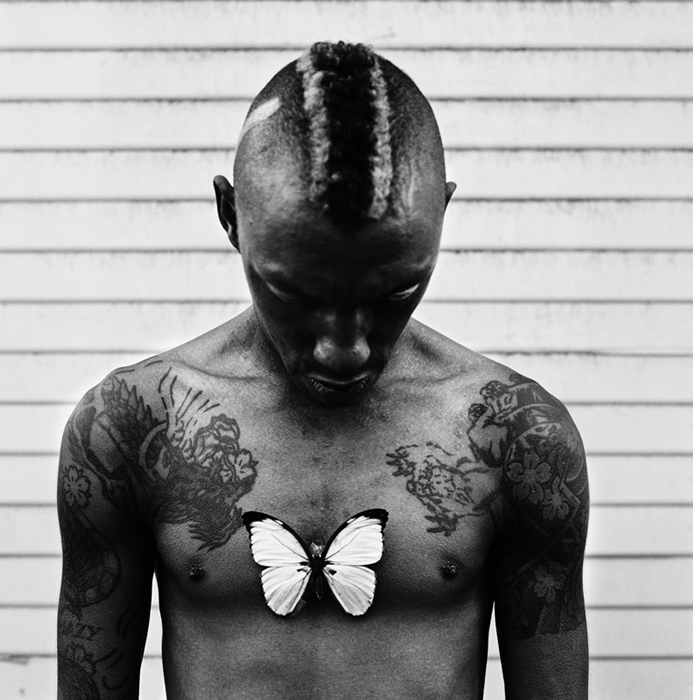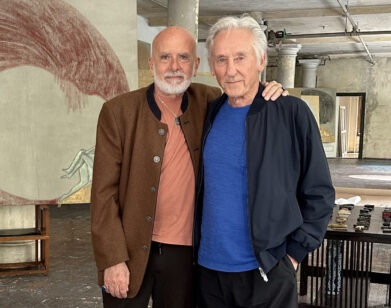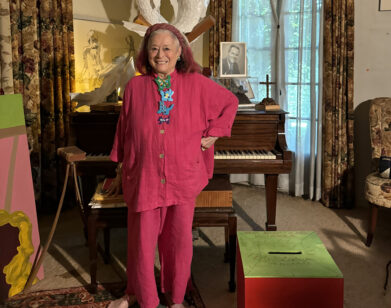Anton Corbijn is Still in Control

TRICKY. COURTESY THE ARTIST
As a teenager, Anton Corbijn left the small Dutch island where he grew up; and ever since, his gritty but vibrant pop imagery has taken the form of photographs, album covers, music videos, even films that capture some of the greatest moments of the greatest musicians of the past three decades—from U2 and Depeche Mode to Nirvana, Johnny Cash, and Joy Division. The latter among these provided the focus for his first motion picture, Control, followed up this year by the George Clooney suspense thriller, The American.
“Those first 30 years feel like they belong together,” says Corbijn holding up his books Famouz, Star Trak, 33 Still Lives and A. Somebody as examples. “All four of these go around one concept, but in my mind I had to find a new concept, which I realized was just going back to basics.” Translation: Corbijn and a stripped down black-and-white image, 10 examples of which are on display starting today at Stellan Holm Gallery. Whether it’s a menacing shot of Alexander McQueen with a bandanna tied around his face, Kate Moss with a mask around hers, Gerhard Richter staring at one of his paintings, or Lucian Freud staring off into the distance, Inwards and Onwards is about tapping into the explosive vulnerability of the artist—gravelly, unadulterated, just on the verge of that barbaric, Whitmanesque yawp.
“It’s people I admire the work of, and it’s very simple. I won’t say it’s fan-like, but a camera is a great way to get to places that you find interesting, because it’s an excuse to meet somebody. It’s great to be in the surroundings of really clever and intelligent and expressive people,” says Corbijn of the impulses beyond these shots. As the polls opened Tuesday, we sat down in the lobby of New York’s Thompson Hotel, where he held forth on U.S. politics, the politics of making Control, his photo methods, and his next big project—which we’d love to see in 3-D.
MICHAEL SLENSKE: You’re here on election day.
ANTON CORBIJN: Yeah, it’s scary to see the Tea Party people. I think it’s good that politics are being discussed amongst everybody, you know.
SLENSKE: What do you think of the election process here?
CORBIJN: I think midterms are a really bad idea, because policies need time to actually work, and politicians only think in the short term. But I think four years is short-term, in a way, to affect change. After two years you can’t change something. So I think it’s very negative that they exist.
SLENSKE: Well, at least you’re here when it’s interesting.
CORBIJN: Yeah, sure.
SLENSKE: Enough about politics. What do you think makes the perfect image for you? What are you hoping to find?
CORBIJN: I’m actually not so sure what I’m hoping to find. You always want to come back with an image that’s interesting visually, and you hope to get something from the person you photograph that’s different than other images you know of these people. I don’t know how I go about it. I also don’t know how exactly what I set out to get other than these two things.
SLENSKE: Going back to basics, what does that mean for you?
CORBIJN: Oh, basics means “basic” in my approach. I come unprepared. I don’t have lights, I don’t have assistants, I just go and meet somebody and take a photograph. That’s really basic, and that’s how I used to work when I was 17 or 18 in Holland. I was given very little time to photograph people and I was very scared.
SLENSKE: Like Herman Brood?
CORBIJN: For instance, yeah. Wow, I’m surprised you even know that name. Yeah. But he was a flamboyant character, which helped a lot in that sense. But the approach is similar. The only way I’m prepared is the photograph and what I know about their work.
SLENSKE: Is it better in a way to come unprepared because you can get more from [your subject]?
CORBIJN: I think so. At least for me it works. I think some people need the assurance of people around them and ideas worked out in advance. I think it keeps me an edge that to be creative on the spot. You have to think of things to do when you meet people. It’s also how people like Brian Eno work. You limit your choices from the beginning. So I don’t bring a lot of lenses, cameras, all these elements that can help the picture. You confine yourself to, say, one room and you just make it work. You become very creative in that little space. You have left a lot of other options out of the game.
SLENSKE: It’s sort of the anti-David LaChappelle approach?
CORBIJN: Oh, yeah. Or Annie Leibovitz, or any of these people.
SLENSKE: It seems like you focus on light and color.
CORBIJN: Well, I shoot black-and-white now.
SLENSKE: Yeah, but in the past you’ve had the blue and brown photos and the washed-out color photos?
CORBIJN: Yeah, the color was Polychrome. It’s a Polaroid film that doesn’t exist anymore. You develop it in a little box, and it’s basically instant slides that are very grainy. When you blow it up you see lines, like television-screen lines. I was always comfortable with seeing how a photograph is built up—the grain. I liked that, so I always used film that was quite grainy, because I felt that it had an imperfection to it and the feel that you stole a moment somewhere.
SLENSKE: You’re very concerned with painters in this show.
CORBIJN: The painters is a big thing for me, because what I’d have like to have been was a painter, but I’m hopeless. I’ve used a paintbrush in some of my designs because I’ve liked the paintbrush feel, but I can’t paint. My grandfather was a painter and did very boring painting.
SLENSKE: Very boring?
CORBIJN: Very boring still-lifes. It’s absolutely not how I wanted to be a painter.
SLENSKE: What did you want to do?
CORBIJN: Well, I love Marlene Dumas. She’s a good friend. We did some shows together 10 years ago. I shot her as well. Also, her new Phaidon book, I shot the beginning image. But I took a picture of her for my series in Amsterdam in 2000. We did these exhibitions together and went to strip clubs together and selected girls and asked if they wanted to participate and she painted them and I photographed them. Then we had the shows together, but, you know, her paintings were far more interesting than my photographs. I knew that from the start. Also, the quality the painting has, it’s less defined, so you can get more subtle things out of it than with photographs.
SLENSKE: Obviously you’ve had some longstanding relationships with U2 and Depeche Mode.
CORBIJN: Tom Waits.
SLENSKE: Yep. What makes you want to photograph someone?
CORBIJN: Well, in the early days it was my desire to become part of the music world, which I thought was much more interesting than the world I was living in. My father was a minister and everybody in my family was ministers: my grandfather, my uncles.
SLENSKE: What kind?
CORBIJN: Protestant. And growing up on an island it’s very prominently there, so everything that came from outside of the island had a strong attraction for me. So it was a very basic desire to become part of a different world.
SLENSKE: Did it shock your parents when you went off to become a photographer?
CORBIJN: Well, I think they were happy that I had a hobby. It’s only when I stopped studying that they became a little worried. They come from a generation where you study and become a doctor or something. But they have been supportive.
SLENSKE: What’s kept you going with Bono and U2 and Depeche Mode and Dave?
CORBIJN: I think the fact that you have long-term relationships, this is a very unusual thing in the world, and I thought it was fantastic because you build up a trust. Each time you photograph the person, you try to do something else.
U2’s “PRIDE (IN THE NAME OF LOVE)” VIDEO, DIRECTED BY CORBIJN
SLENSKE: So tell me about starting with U2. Was Joshua Tree the first collaboration?
CORBIJN: Oh, no, ’82. They had just released October. It was really early on. I also did Unforgettable Fire, I did the inside for War.
SLENSKE: Do they come to you, do you come to them?
CORBIJN: Well, when there’s an album they come to me to discuss with me. With Joshua Tree, it was the idea of going to the desert. They had another title, called The Two Americas or The Desert Songs. Joshua Tree came from me. That’s just because I liked these images I’d found of Captain Beefheart in the eighties. Unforgettable Fire was their title, and I came up with the idea for these castles, these ruins, and then I shot it on infrared. With Achtung Baby, that came from a lot of my Depeche Mode work I did in color, and Bono really liked these vibrant colors, and also the desire to create a very different feeling for the band than we did on Joshua Tree. They’re very open to my ideas, and I’m very open to their ideas. But these days, I feel Bono’s ideas are so big sometimes they sometimes needs me to make them more balanced or on the ground. If Bono thinks of a rocket going up in the sky I translate it into a kite, holding a kite on the beach, because he thinks so big and I think so basic always. Somehow what we do becomes something people relate to.
SLENSKE: So how does that differ from working with Depeche Mode?
CORBIJN: Well, it’s more about atmosphere. They don’t put themselves on the cover. U2 is all about, “This is a rock band.” Depeche Mode is different. Although they’ve become more so, they’re not very involved. They say, “Can you do the album?” and I come up with an idea.
SLENSKE: That’s more you being the painter, in a way.
CORBIJN: Absolutely. They’ve been fantastic with me in that sense—like with Violator, I just painted a flower red and nailed it to a board and wrote under it, “Violator.”
NIRVANA’S “HEART-SHAPED BOX” VIDEO, DIRECTED BY CORBIJN
SLENSKE: What do you like better, photography or film?
CORBIJN: Well, I think with film there’s more excitement for me because it’s an adventure. It’s so new, and it’s such a different way of thinking for me. For some photographers who work with more assistants and lights and direct more on the set, if you like, maybe the change for them is not so large. But for me it’s a massive change to go with your camera and meet someone to having 160 people working for you.
SLENSKE: Is that why you did Control first, because you were in that world already?
CORBIJN: Well, Control had to do with my own life a lot, and that’s why that seemed to be a film I could be the director of, because I had an emotional attachment to the whole story. And because of that experience, I feel that I can try other films. I didn’t set out to become a director.
SLENSKE: What was the approach to that movie? Did you know what you wanted to do from the beginning or was it more like the photos?
CORBIJN: Kind of. The book [Touching From A Distance by Deborah Curtis, Ian’s wife] was the starting point, but the film is not a film of the book. We had access to that, but I also wanted to have the input of the girlfriend, Anik, and, of course, the book would never tell that. I don’t think Debbie likes the movie now, she did in the beginning, but no longer, because it’s something she didn’t want to see happening, I think, that it’s really a film about Ian rather than her relationship with Ian. [ROLLS HIS EYES] It’s unbelievable.
SLENSKE: It sounds like you’re still dealing with it?
CORBIJN: Well, the criticism you can get for doing things from your heart. I had to sell my house in England. I live in Holland because of that film. There was nobody in Manchester who wanted to put money into the film, nobody apart from me, I put everything into it, and I still get criticism, “Well, you moved to London and you didn’t even come to Manchester. You didn’t really care about these people.” Whatever you do these days, especially with the Internet, there’s always somebody who’s… It’s funny there’s also people who seem to be eternally frustrated and can’t get out of that period. I’m not going to go into it.
SLENSKE: So how did The American come about?
CORBIJN: Well, after Control, and after how much I liked having made that film, I wanted to have another experience, and the experience had to be very different from Control, so I set out to make a movie that is in many aspects very different in genre and nationality of the actors. That’s why The American is called The American and not The Private Gentleman. The book is about an English guy. So I looked at thrillers, dark comedies, all these things I could see in myself. I found something I could invest myself in, the question in the film is really if a man can really change his life. It’s the core of the film. And it’s about a loner just as Control was about a loner.
SLENSKE: Do you want to write your next film?
CORBIJN: No, but I’m part of the development of the script.
SLENSKE: What is it?
CORBIJN: Well, I’m working on two ideas at the moment. Both from books.
SLENSKE: Can you discuss them?
CORBIJN: No, because I think they need to be in a further stage.
SLENSKE: What are they about, roughly speaking?
CORBIJN: Animation and 3-D. I think that’s the future.
SLENSKE: Really?
CORBIJN: No. [LAUGHS] I have not seen a film in 3-D yet. I haven’t even seen Avatar. It just doesn’t interest me. [LAUGHS] No… I need to do a film that’s a slightly different genre, to get another experience.
SLENSKE: More of the loner?
CORBIJN: Maybe more of the loner, but the genre needs to be different. I’m working on one that’s more of a political thriller, and one that’s more absurd. And you get at least a script a week.
SLENSKE: Is that annoying?
CORBIJN: No, it’s okay. They come from my agent, who reads them first. But it throws you sometimes.
SLENSKE: You know, I can’t get over that McQueen photo. It’s very odd and very striking in a weird way.
CORBIJN: It’s like a guerilla artist in a way. Fashion terrorist.
SLENSKE: So is that the through line, all these people are artists?
CORBIJN: Yeah.
SLENSKE: Even Kate Moss?
CORBIJN: I think Kate is an amazing artist. It’s an old photograph of her. I have another old photograph of Johnny Cash, which is also 1993. They somehow feel a part of it, apart from Mandela who… Mandela is just the eternal man. You want that man to be around forever. It’s the closest thing we have to god, I think. He’s the father of mankind almost. It feels like that, working with him.
INWARDS & ONWARDS IS ON VIEW AT STELLAN HOLM GALLERY THROUGH DECEMBER 15.






